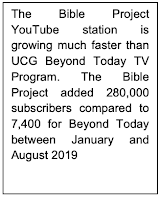New Beyond Today TV Studio Set Installed
Preaching the Gospel in the Internet Age
By Jack Oakes
The UCG TV studio is an example of where most of the Church of God (COG) community are going wrong. Their thinking on preaching is still stuck in the 1980’s or even earlier. They are not adapting their preaching to current times.
T
| UCG Beyond Today TV Program shows no increase in the growth rate of subscribers since the use of their new TV Studio which started in January 2019.
Fig 1 UCG Beyond Today YouTube subscribers.(1)
|
TV ratings are on the decline, especially among young people.(2) The 4 main US TV networks combined audience declined by 4.8 million viewers or 16% in the 4 years from 2014 to 2017.(3)Popular current affairs programs such as 60 Minutes ratings have declined from the 20’s up until the mid 1990’s to as low as 7.7 in 2015-16 to recover to 12.5
To take an old-style talking heads TV format, supplant it into social media such as YouTube, does not fix the problem of declining TV audiences. COG’s need to reassess how they preach.Let me quote from Professor Peter Horsfield, Professor of Communication at RMIT University in Melbourne Australia who previously worked for the United church (a mainstream Australian Protestant church). He sums it up this way.
“When you look at the history of Christianity, it has been a history of writing based and printing based institutions organised around power structures and sustained by having elite leaders who are educated in writing and printing. Most of the mainline denominations are fundamentally print based organisations. They operate institutionally out of bureaucracies for example.” (5)Sound familiar? Herbert Armstrong’s background was print advertising. Horsfield goes on to say -
What digital media has done is that they have not only challenged the way in which churches communicate, they have actually changed the fundamental media environment which previously sustained the sort of organisation that Christianity has had. It is changing quite considerably and that partly explains the decline in the number of people in mainline churches now. And the increasing age of members because churches still address a culture that is now a past culture.(5)Horsfield is writing about mainline Protestant churches, but he could just as well have been talking about COG’s.
The Bible Project uses short animated videos to reach its audience; not talking heads.
In comparison to the Good News TV station subscriber growth of 7,400 or 17% since January, The Bible Project has grown by 280,000 or 24% to 1.45 million subscribers.
The Bible Project YouTube station is growing much faster than UCG Beyond Today TV Program. The Bible Project added 280,000 subscribers compared to 7,400 for Beyond Today between January and August 2019.
Fig 2 UCG Beyond Today YouTube compared to The Bible Project subscribers.(1)
|
Another example of YouTube success is the conservative commentator Denis Prager.
Prager changed his YouTube format to animation-based mode in 2013. This change resulted in a increase in subscribers.
Prager changed his YouTube format to animation-based mode in 2013. This change resulted in a increase in subscribers.
“This year [2015] 1we will have more than 50 million views as confirmed by YouTube and Facebook,” Prager says in an email to The Daily Signal, adding that “the largest single demographic of our videos are people under 35 years of age.”(7)COG’s more specialised message will never have the mass appeal of a more general Bible message like The Bible Project. However, it would have been more effective for UCG to spend their members/donors $1 million on a different format to talking heads such as an animation-based model.
My plea is for COG’s review their media preaching and move into the twenty first century.
References :
(1) I regularly accessed the Beyond Today TV and The Bible Project YouTube stations on the internet to progressively record their subscriber numbers. I realise this is not the only platform UCG use, nor am I aware of any advertising support they may have used to support their YouTube results.
Subscribers usually indicate an interest in the station. Views on the other hand can be fleeting and hard to evaluate their quality of interest.
Subscribers usually indicate an interest in the station. Views on the other hand can be fleeting and hard to evaluate their quality of interest.
YouTube Subscribers
| ||
Date
|
Beyond Today
|
The Bible Project
|
25-Jun-18
|
32,110
|
878,364
|
19-Jan-19
|
43,426
|
1,174,863
|
19-Aug-19
|
50,841
|
1,454,823
|
(2) Why Traditional TV Is in Trouble. No Choice for Marketers But to Rethink TV Ads. New York Times May 14, 2018 Sapna Maheshwari and John Koblin
https://www.nytimes.com/2018/05/13/business/media/television-advertising.html [Accessed 18 August 2019]
(3) https://en.wikipedia.org/wiki/Nielsen_ratings. [Accessed 18 July 2019].
(4)https://en.wikipedia.org/wiki/60_Minutes. [Accessed 18 July 2019]
(5) The Medium is the Message. ABC Radio RN. The Spirit of Things. 23 August 2015 Professor Peter Horsfield. Professor of Communication at RMIT University, Melbourne, Peter was Dean of the Uniting Church Theological Hall, Melbourne, from 1987-1996 and Lecturer in Applied Theology at the United Faculty of Theology in Melbourne. From 1997-2005, Peter was a member of the International Study Commission on Media Religion and Culture. Author of many books including “From Jesus to the Internet: A History of Christianity and Media (2015)”.
https://www.abc.net.au/radionational/programs/spiritofthings/the-media-is-the--message/6703146 [Accessed 18 August 2019]
(6) The Bible Project was started in 2014 by Timothy Mackie and Jonathan Collins who originally met at the Multnomah Bible College. Their stated goal - ” The Bible is one unified story that leads to Jesus, but we don't always treat it that way. At The Bible Project, we make animated videos that explore the books and themes of the Bible.”
https://www.youtube.com/channel/UCVfwlh9XpX2Y_tQfjeln9QA [Accessed 19 July 2019]
(7) How Dennis Prager’s Conservative Online University Reaches Millions Madaline Donnelly November 04, 2015. The Daily Signal






